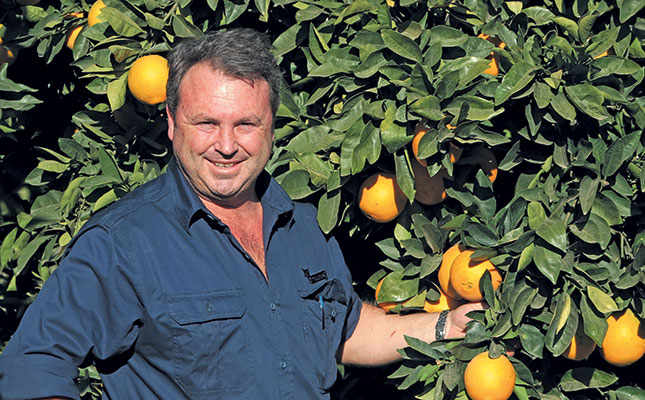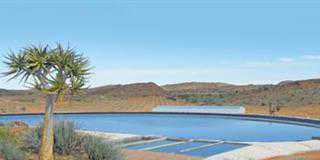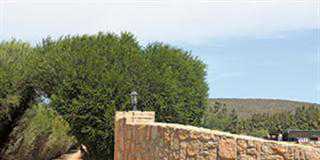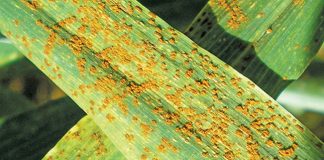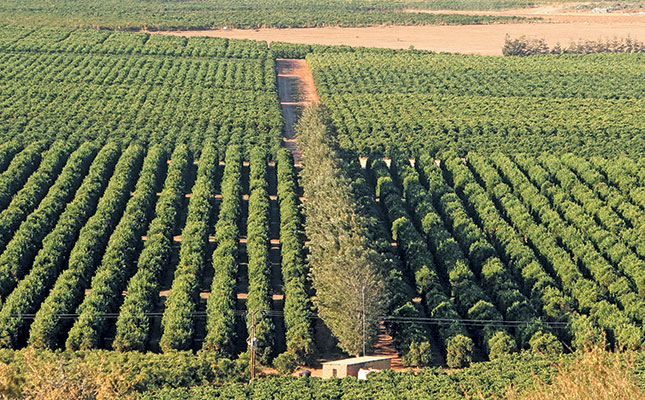
Kirkwood citrus farmer, Pieter Nortje, had to make brave decisions when he turned the family farm, Sitrusrand, into a large-scale citrus production and packing business. Today, it exports 2,3 million cartons to 47 countries.
In the beginning
Pieter’s grandfather, also called Pieter, came to Kirkwood with his family in 1890, and started out with a 10ha mixed farming operation. His father, Anno, introduced citrus in 1972.
After graduating from Stellenbosch University with a BCom in Accounting, Pieter joined his father on the family farm in 1994. A year later, he decided to build a packhouse on the farm.
“It was a big step and maybe it was ignorance that led us down that path, but fortune favours the brave and I always knew I wanted to farm on a bigger scale,” he recalls.
“So, in the difficult years, I bought more farms and just didn’t think of anything else but growing the business.”
The Nortjes farm 1 100ha of citrus in the Sundays River Valley, with some orchards on the warmer western side of the valley, while other farms are situated in the eastern part of the valley (closer to the sea), where it is cooler.
In 2001, Pieter took over the citrus production from his father, who now oversees the game on the farm. Today, Pieter farms 26 citrus varieties. He says the capacity of the packhouses and the operation’s marketing programme guides him in production planning and determining what the market wants.
“Travelling the world has helped me to see [what is bought] on different world markets. For each of the major citrus groupings, we want a season that is as long as possible, to [enable us to] meet demand and have a continuous supply for customers.”
A separate profit and loss statement is kept for each variety.
“There are always new varieties that are more sexy and profitable, but if we were to take out all the varieties that sometimes don’t make money, we’d have nothing left,” he explains.
“Our motto is to have the full basket. In my experience, there has never been a year in which every variety did well or every variety did badly.”
Changing trends
Consumer habits constantly change. For example, people worldwide are eating less grapefruit and more soft citrus. Lemons have also taken off due to their health benefits, and Pieter says the Sundays River Valley produces the best in the world.
“We have the ideal climate for lemons, yet in the late 1980s we didn’t even harvest them because they were so unprofitable.”
But, he says, they are in a very good cycle at the moment having experienced four or five years of good returns. Pieter is concerned, however, that this high returns cycle will not last. “Lemon plantings have increased three-fold and there won’t be a market for this [large volume].”
Growing exports
Although Sitrusrand exported 2,3 million cartons of citrus over the last four years, Pieter says exports are expected to reach 3,5 million cartons in the next three years, due to new plantings.
They export to 47 countries, ranging from Canada, the UK, Europe, the Middle East and Russia, to the Far East. Pieter says he has a good business relationship with Mark and Craig Jensen of the export company, Safpro, which handles his exports. The operation also uses the cold storage facilities at Coega port to save costs.
According to Pieter, his business has made great strides in delivering directly to the end-customer and cutting out the cost of the middleman.
Producing a consistently good product and nurturing client relationships are crucial for successful export marketing, he stresses.
“The exchange rate also has a huge impact on us. When the rand weakens, our input costs go up and the prices we earn for our products don’t necessarily increase to the same extent. [Citrus varieties] are not high-value products so you have to manage small margins.”
Three packhouses
Pieter recalls that Sitrusrand’s first packhouse “was very primitive”.
“The first year was tough and when it became financially viable, I decided to look into the latest technology. I looked at packhouses in Europe, rebuilt our packhouses and fitted the latest equipment.”
Sitrusrand has dedicated packhouses for oranges, lemons and soft citrus. Fruit is sorted and graded using optical sorting machines.
Mechanical sorting was introduced not to minimise labour input, but to eliminate human error, ensuring consistent quality of delivered products.
“With the markets we service, and their speciality needs, it’s impossible to do it all by hand,” Pieter explains.
To further ensure consistent, high quality produce, he worked closely with a manufacturer in the Netherlands to develop the necessary equipment.
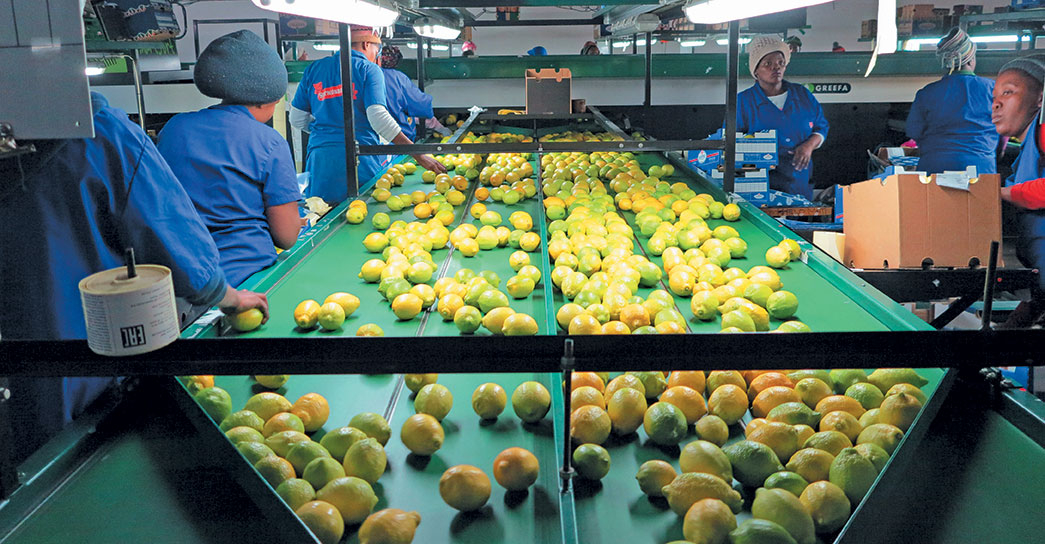
Lemons are carefully sorted in the packhouse.
With the equipment and management in place, the 450 staff members in the three packhouses were able to increase packing capacity from one million cartons seven years ago to 2,3 million cartons today. However, to achieve this, Sitrusrand’s staff, who are all recruited locally, now require more advanced skills.
Each division has its own manager, who all report directly to Pieter.
In addition to staff in the three packhouses, an additional 700 workers are permanently employed for picking.
There are seven production units on the farms, each with its own farm manager who is responsible for 80ha to 200ha of orchards.
Pieter provides his farm managers with information and production guidelines, schedules harvesting and does the planning for the packhouses. Each of the three packhouses has a line manager who focuses on the product that the packhouse specialises in, which makes the operation more efficient.
To empower loyal staff who have more than 10 years’ service, Pieter bought a neighbouring farm and established the Simunye Workers’ Trust. He identified 88 long- serving employees – 47 women from the packhouses and 41 men who work on the farms.
All were given a 30% shareholding in this farm, which Pieter financed at no interest, while the remaining 70% is held by Sitrusrand. The trust has been running for four years and according to Pieter, has been highly successful, with staff receiving dividends despite the farm still being developed.
“I foresee we’ll increase their shareholding in the future,” he says. “That was my contribution to land reform, to have at least 88 people fully empowered.”
Production cycles
The production cycle starts in February with lemons, which are produced for 11 months of the year. The first soft citrus variety, Satsuma tangerines, are harvested in early March. Other varieties include Sonette (picked in April), Nova mandarins (at the end of April), and Clementines (until the end of June).
Mineolas and Murcotts are also harvested from the end of June onwards. After that, in mid-July, Valley Gold and Nadorcott varieties are harvested, followed by Orr and Morr late mandarins in August.
Early navels are harvested in April, May and June, and later navels (Autumn Gold, Witkrans and Cambria) at the end of July until the end of August.
For Valencia oranges, the season starts with Midnight and Delta seedless varieties in mid-July. The Star Ruby grapefruit variety is harvested from mid- July until the end of August, but according to Pieter this no longer forms a major part of the operation.
“In total, we have about 26 varieties and harvest from mid-February to mid- September.
It’s only really for the first two weeks in February that we’re not harvesting flat out and that’s when serious irrigation takes place.
Essentially, we have a 15-month production season; at the end of July, we start with the first foliar sprays to kick-start the forming of buds and flowering in September. So, while we’re in the middle of harvesting, our next production cycle starts – there’s no downtime.”
Pruning is undertaken immediately after an orchard is harvested. A total of 60 pruners are permanently employed, and each farm has a dedicated pruning team.
“Fertilising and spraying starts at the end of July and this determines your next year. The crop is already decided by the end of July,” says Pieter.
Fertigation is undertaken from mid-July to December, while spraying starts mid-August and lasts until February or March. It is carried out at night when the temperature is lower and there is generally no wind.
So when day-shift workers go home, night-shift workers start with spraying. Pieter has adopted an holistic approach to fertilising and bases it on the results of soil analyses.
He has also invested heavily in mulching material and machinery, but says he now spends 20% less on fertiliser than two years ago as a result of improved soil health, which has resulted in improved fruit quality.
“We use chemical fertilisers and soil health products such as Trichoderma and soil improvement bacteria which we introduce to the soil,” he says.
Approximately 95% of Sitrusrand is under drip irrigation and all fertiliser and soil health products are administered through the irrigation system. Previously, irrigation was applied at a rate of 700mm/ ha to 900mm/ ha annually, but this has been reduced to between 500mm/ ha and 600mm/ ha per year.
“This enables us to plant more hectares with the same amount of water – stretching the water allocation per hectare by 30%,” Pieter explains.
Soil types
Soil types range from sandy loam in the valley basin to limestone and clay on the sides of the valley. Pieter has conducted a thorough study of the most suitable citrus varieties and soil types, the ideal micro-climate and rootstock, as well as the optimal time to harvest each variety. These varieties are then ‘manipulated’ to be ready in time for this picking window.
A soil preparation division uses earthmoving equipment to prepare soil for planting.
“In the old valley soils, we deep- plough using bulldozers. In the outer valley, we do deep-ripping of the soil [to facilitate] water penetration, because we don’t want to bring limestone to the surface. So we don’t plough there,” he says.
Pest control
Thrips is the main pest encountered and is controlled with preventative spraying.
False codling moth (FCM) is controlled through the X sterile insect technique (XSIT), an initiative of Citrus Research International.
This biological insect control method entails releasing large numbers of sterile insects into the natural environment. The released insects are normally male, as females cause damage by laying eggs in crop plants.
Pieter says that up to five years ago, FCM was a major problem, but this programme has reduced the population four-fold in four years.
“Citrus black spot is not a production issue but the level of detection is so high that you cannot afford a single spot. This has doubled our spraying costs.”
The industry spends about R1 billion a year n chemicals spraying for black spot, which is harmful to the atmosphere, but this is a requirement of the EU market, he says.
Pieter says the lifespan of citrus trees depends on root health, which is in turn dependent on soil preparation and irrigation.
Secret to success
Consistent attention to detail is the secret to successful citrus farming, Pieter says. “There’s no luck. What you put in you will get out. If you make a mistake, it’ll come back to bite you a year later. To me, there’s no option but to succeed. It’s not just for myself, a lot of people are depending on me. Sometimes, to keep all the balls in the air, you have to be a magician!”
Phone Pieter Nortje of Sitrusrand on 042 232 0132, or email him at [email protected].

